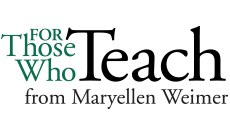Students often think of class sessions as isolated events—each containing a discrete chunk of content. Those who take notes during class will put the date along the top and then usually leave a space between each session, which visually reinforces their belief that the concepts and material aren’t connected. But in most of our courses, today’s content links to material from the previous session as well as to what’s coming up next. A lot happens in the lives of students between class sessions, though, and if they don’t anticipate a quiz, how many review their notes before arriving in class? And so the teacher starts class with a review.

Having a quick recap is a good idea, but what about having students prepare and present that review? That’s what Professor Annie Blazer does. Each of her class sessions begins with a three- to-five-minute summary of the main ideas discussed in the previous session, and that summary is presented by a student. Each student signs up to do a summary, as this is a course assignment. Blazer leads off with the first one showing students what she expects the review to cover. Their summaries must contain the “three elements of greatest significance” from the previous session (p. 344). To identify these elements, Blazer refers students to discussion questions that appear on the syllabus, course objectives, and their own insights as to the central themes of the current unit. “To receive full credit on this assignment, a student must correctly identify the most relevant information from a class session, summarize and prioritize this information, and deliver it confidently to the class.” (p. 344)
The assignment has a number of benefits. It refreshes students’ memories—reminding them about content and topics from the previous session. It’s a low-stakes way to help students develop presentation skills. They have the opportunity to practice speaking in front of their peers, and they get feedback from the instructor. The quality of a prepared summary is better than if the instructor simply calls on a students and asks what happened last time the class met. Confronted with the pressure of having to do the next session summary motivates serious and detailed note-taking, followed by some review and analysis of those notes in preparation for leading the next review session. There’s a chance those two activities may show students the value of careful note-taking and review, and not just when they’re on deck.
Various iterations of the assignment are possible. If there’s no time for the review or it’s an online course, the student summary could be posted on the course website. It could be formatted as a single document that students could download and use to guide the review of class notes when preparing for an exam. Or perhaps what students prepare isn’t a summary, but a list of three or four ways the material presented in class relates to material in the assigned reading or content covered in the previous unit.
Different grading options could be used. Maybe this is an extra credit assignment, worth more when the summary is of a week’s worth of class sessions or of the whole unit. Maybe preparation and posting of the summary is another way to get credit for “participating” in the course. We have written before in the blog about the value of broadening our definitions for what counts as participation so that students who find it hard to speak up in class can still contribute in ways that support the learning efforts of others.
The activity is a great example of a learning task that students should be doing, rather than having the teacher do it for them. It’s nice (and easy) for them when they get a summary provided by the teacher, but that doesn’t teach them how to create a summary and it doesn’t force an encounter with the content that reveals how much of it they do or don’t understand. Teachers do learning tasks like these for students, motivated by good intentions. Most students, certainly those who weren’t in class, aren’t going to summarize the session as well as the teacher can. The teacher’s summary will be accurate, well organized, and coherent. That’s a lovely gift to give students, but it’s not as valuable or enduring as the gift that teaches students how to do their own summaries.
Reference: Blazer, A. (2014). Student summaries of class sessions.
Teaching Theology and Religion, 17 (4), 344.







 Having a quick recap is a good idea, but what about having students prepare and present that review? That’s what Professor Annie Blazer does. Each of her class sessions begins with a three- to-five-minute summary of the main ideas discussed in the previous session, and that summary is presented by a student. Each student signs up to do a summary, as this is a course assignment. Blazer leads off with the first one showing students what she expects the review to cover. Their summaries must contain the “three elements of greatest significance” from the previous session (p. 344). To identify these elements, Blazer refers students to discussion questions that appear on the syllabus, course objectives, and their own insights as to the central themes of the current unit. “To receive full credit on this assignment, a student must correctly identify the most relevant information from a class session, summarize and prioritize this information, and deliver it confidently to the class.” (p. 344)
The assignment has a number of benefits. It refreshes students’ memories—reminding them about content and topics from the previous session. It’s a low-stakes way to help students develop presentation skills. They have the opportunity to practice speaking in front of their peers, and they get feedback from the instructor. The quality of a prepared summary is better than if the instructor simply calls on a students and asks what happened last time the class met. Confronted with the pressure of having to do the next session summary motivates serious and detailed note-taking, followed by some review and analysis of those notes in preparation for leading the next review session. There’s a chance those two activities may show students the value of careful note-taking and review, and not just when they’re on deck.
Various iterations of the assignment are possible. If there’s no time for the review or it’s an online course, the student summary could be posted on the course website. It could be formatted as a single document that students could download and use to guide the review of class notes when preparing for an exam. Or perhaps what students prepare isn’t a summary, but a list of three or four ways the material presented in class relates to material in the assigned reading or content covered in the previous unit.
Different grading options could be used. Maybe this is an extra credit assignment, worth more when the summary is of a week’s worth of class sessions or of the whole unit. Maybe preparation and posting of the summary is another way to get credit for “participating” in the course. We have written before in the blog about the value of broadening our definitions for what counts as participation so that students who find it hard to speak up in class can still contribute in ways that support the learning efforts of others.
The activity is a great example of a learning task that students should be doing, rather than having the teacher do it for them. It’s nice (and easy) for them when they get a summary provided by the teacher, but that doesn’t teach them how to create a summary and it doesn’t force an encounter with the content that reveals how much of it they do or don’t understand. Teachers do learning tasks like these for students, motivated by good intentions. Most students, certainly those who weren’t in class, aren’t going to summarize the session as well as the teacher can. The teacher’s summary will be accurate, well organized, and coherent. That’s a lovely gift to give students, but it’s not as valuable or enduring as the gift that teaches students how to do their own summaries.
Reference: Blazer, A. (2014). Student summaries of class sessions. Teaching Theology and Religion, 17 (4), 344.
Having a quick recap is a good idea, but what about having students prepare and present that review? That’s what Professor Annie Blazer does. Each of her class sessions begins with a three- to-five-minute summary of the main ideas discussed in the previous session, and that summary is presented by a student. Each student signs up to do a summary, as this is a course assignment. Blazer leads off with the first one showing students what she expects the review to cover. Their summaries must contain the “three elements of greatest significance” from the previous session (p. 344). To identify these elements, Blazer refers students to discussion questions that appear on the syllabus, course objectives, and their own insights as to the central themes of the current unit. “To receive full credit on this assignment, a student must correctly identify the most relevant information from a class session, summarize and prioritize this information, and deliver it confidently to the class.” (p. 344)
The assignment has a number of benefits. It refreshes students’ memories—reminding them about content and topics from the previous session. It’s a low-stakes way to help students develop presentation skills. They have the opportunity to practice speaking in front of their peers, and they get feedback from the instructor. The quality of a prepared summary is better than if the instructor simply calls on a students and asks what happened last time the class met. Confronted with the pressure of having to do the next session summary motivates serious and detailed note-taking, followed by some review and analysis of those notes in preparation for leading the next review session. There’s a chance those two activities may show students the value of careful note-taking and review, and not just when they’re on deck.
Various iterations of the assignment are possible. If there’s no time for the review or it’s an online course, the student summary could be posted on the course website. It could be formatted as a single document that students could download and use to guide the review of class notes when preparing for an exam. Or perhaps what students prepare isn’t a summary, but a list of three or four ways the material presented in class relates to material in the assigned reading or content covered in the previous unit.
Different grading options could be used. Maybe this is an extra credit assignment, worth more when the summary is of a week’s worth of class sessions or of the whole unit. Maybe preparation and posting of the summary is another way to get credit for “participating” in the course. We have written before in the blog about the value of broadening our definitions for what counts as participation so that students who find it hard to speak up in class can still contribute in ways that support the learning efforts of others.
The activity is a great example of a learning task that students should be doing, rather than having the teacher do it for them. It’s nice (and easy) for them when they get a summary provided by the teacher, but that doesn’t teach them how to create a summary and it doesn’t force an encounter with the content that reveals how much of it they do or don’t understand. Teachers do learning tasks like these for students, motivated by good intentions. Most students, certainly those who weren’t in class, aren’t going to summarize the session as well as the teacher can. The teacher’s summary will be accurate, well organized, and coherent. That’s a lovely gift to give students, but it’s not as valuable or enduring as the gift that teaches students how to do their own summaries.
Reference: Blazer, A. (2014). Student summaries of class sessions. Teaching Theology and Religion, 17 (4), 344.